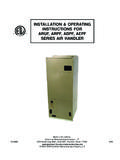Transcription of Sound Advice for Ventilation Plant in Schools - Air Handlers
1 Sound Advice forVentilation Plantin SchoolsBy David PinchbeckLow Energy, Air Source, Heat Pump SystemAir Source Renewable EnergyClassventEngineering SolutionsAIR Handlers LTD1262 Acoustic Testing LaboratoryCollege of Science & TechnologyIndex of ContentsSound Advice for Ventilation Plant in SchoolsDavid PinchbeckINDEX OF CONTENTSB uilding Bulletin 93 Acoustic Performance ChartsRoom Classification NoisePage 1 Room Classification ReverberationPage 29 Method of Noise Control for Mechanical Services PlantRoof/ External PlantPage 2 Plant room PlantPages2/3 Internal Ceiling PlantPages3-6 Types of Mechanical Ventilation PlantPages7-13 Heat Reclaim Classvent (HRU)Page 14 Noise Consideration for the DesignerAtmospheric NoisePages14-22 Internal NoisePages27-40 Noise Rating (NR)Noise Rating CurvesPage 26 Noise Rating ChartsPage 26 Tonal InfluencePage 27 End ReflectionPage 21 DirectivityPages20/21 Impact Decay on Atmospheric Sound PathPage 16 Sound Pressure/Power AdditionPage 23 A WeightingPages23/24 Atmospheric Side Calculation SheetPage 25 Reverberation Time Effect and ChartsCorrection for Reverberation TimePage 31 Correction for Room VolumePages32-34 Absorption in RoomsTypical Absorption Coefficients of MaterialsPages34/35 Mean Room Absorption Coefficient ChartPage 36 Effect of Room Surface AreaPage 36 Sound Reduction for Air Handling Unit ComponentsPages40-42 Sound AttenuatorsPages42-49 Casework Sound Reduction TestingPages 51-86 Factory Noise TestingPages 87-102 REQUIREMENTS FOR BB93 COMPLIANCE To comply with Building Bulletin 93 Acoustic
2 Design of Schools and Places of Learning we have compiled the following information as a Design Guide to meet both the Building Regulations and BB93 for Schools and Places of Learning. Specification of Acoustic Performance Type of Room Room classification for the purpose of airborne Sound insulation in Table Upper limit for the indoor ambient noise level Activity noise (Source Room) Noise tolerance (Receiving Room) LAeq. 30min (dB) Nursery school playrooms Nursery school quiet rooms High Low Low Low 35 35 Primary school : classrooms, class bases, general Teaching areas, small group rooms Average Low 35 Secondary school : classroom, general teaching areas, seminar rooms, tutorial rooms, language laboratories Average Low 35 Open Plan: Teaching areas Resource areas Average Average Medium Medium 40 40 Music: Music classroom Small practice/group room Ensemble room Performance/recital room Recording studio Control room for recording Very high Very high Very high Very high Very high High Low Low Very low Very low Very low Low 35 35 30 30 30 35 Lecture Rooms.
3 Small (fewer than 50 people) Large (more than 50 people) Average Average Low Very low 35 30 Classrooms designed specifically for use by hearing impaired students (including speech therapy rooms) Average Very low 30 Study room (individual study, withdrawal, remedial work, teacher preparation) Low Low 35 Libraries: Quiet study areas Resource areas Low Average Low Medium 35 40 Science laboratories Average Medium 40 Drama studios High Very low 30 Design and Technology x Resistant Materials, CADCAM areas x Electronics/control, textiles, food, graphics, design/resource areas High Average High Medium 40 40 Arts rooms Average Medium 40 Assembly halls, multi-purpose halls, (drama, PE, audio/visual presentations, assembly, occasional music) High Low 35 Audio-visual, video conference rooms Average Low 35 Atria, circulation spaces used by students Average Medium 45 Indoor sports hall High Medium 40 Dance studio High Medium 40 Gymnasium High Medium 40 Swimming pool High High 50 Interviewing/counselling rooms, medical rooms Low Low 35 Dining rooms High High 45 Ancillary spaces.
4 Kitchens Offices, staff rooms Corridors, stairwells Coats and changing areas Toilets High Average Average-High High Average High Medium High High High 50 40 45 45 50 The Acoustic Performance Specification indoor noise levels are based on an ambient noise level This applies to all teaching spaces and is intended only for guidance in administration and ancillary spaces. Page 1 Sound Advice for Ventilation Plant in SchoolsDavid Pinchbeck AIRBORNE Sound INSULATION BETWEEN SPACES The objective is to attenuate airborne Sound transmission between spaces, through walls, floors and ceilings. Sound INSULATION OF MECHANICAL Ventilation Plant Mechanical Ventilation Plant is located in various areas within the school , and can be one of the following areas: A. ROOF Rooftop Ventilation Plant will be of weatherproof construction, and will normally take its fresh air intake and discharge its exhaust air to atmosphere.
5 Noise transmission from these plants can be passed both back into the building spaces through the roof/windows etc or it can be transmitted to local residencies beyond the school boundaries. There are various ways of suppressing and attenuating rooftop Plant noise and the table below highlights this. ATTENUATION & SUPPRESSION OF ROOF Plant NOISE TABLE 1 AREAS OF CONCERN METHOD OF NOISE CONTROL Direct Noise Transmission Through the Roof This can be from both airborne noise and vibration transmission. 1. Airborne noise can be eliminated with the correct Sound reduction index of the Plant casework. 2. Vibration transmission can be controlled with the correct selection of anti-vibration mountings with a flexible connector on the fan or Plant . Sound Transmission in the Building from Roof Plant 1.
6 Airborne Sound emission from the Plant fresh air and exhaust air louvres can be reduced with attenuators correctly sized to prevent Plant noise entering the school and local residences via windows and building facia. 2. Roof Plant noise transmission from the Plant casework can also transmit into the building and local residences. The correct selection of Plant casework will eliminate this. Sound Transmission via Ductwork into the Building and Room Spaces Airborne Sound emission via the supply and return ductwork. Correctly designed attenuators will reduce this noise into the school spaces. B. PLANTROOM Plant room located Ventilation Plant can be designed to sit on the Plant room floor or be suspended from the ceiling, and will normally take its fresh air and air discharge from ductwork and louvres from within the Plant room external walls.
7 Noise transmission from these plants can be passed back into the building spaces through the emission from the louvres through external windows and facia or can be transmitted to local residences beyond the school boundaries. Other forms of noise transmission are, duct airborne noise from the Plant via the supply & return air ductwork, Plant breakout through adjoining walls and structures, vibration through the floor or ceiling. Page 2 Sound Advice for Ventilation Plant in SchoolsDavid Pinchbeck The table below highlights the methods of suppressing or attenuating Plant room noise emission. ATTENUATION & SUPPRESSION OF PLANTROOM NOISE TABLE 2 AREAS OF CONCERN METHOD OF NOISE CONTROL Noise to atmosphere via Plant room louvres. Noise to atmosphere will be mechanical noise transmitted from the Plant via ductwork discharging exhaust air or bringing fresh air through louvres on the facia of the building.
8 This emission can be controlled with the use of attenuators positioned to prevent flanking of Plant room noise back into the duct after the attenuator. Sound Transmission through the Plant room walls/floor/ceiling This can be from both airborne noise and vibration transmission. 1. Airborne noise can be eliminated with the correct Sound reduction index of the Plant casework. 2. Vibration transmitted into walls, floor and ceiling of Plant rooms can be dampened with correctly sized anti-vibration isolators. Duct borne noise transmitted by the Plant through ductwork into the room spaces Duct borne noise can be reduced by introducing attenuators into the ductwork. The selection of the attenuators must be selected to achieve the room noise requirement. Care must be taken to ensure noise flanking of the attenuators does not take place.
9 A recommended way to avoid flanking is to acoustic lag all ductwork from the attenuator to the Plant room wall. A second method is to position the attenuator directly before or through the Plant room wall. CEILING MOUNTED SUPPLY & EXTRACT Ventilation Plant TABLE 3 AREAS OF CONCERN METHOD OF NOISE CONTROL Direct noise transmission from the Plant into the room This can be from both airborne noise and vibration transmission. The mechanical Ventilation Plant is installed within the ceiling space of the room being served or in a room adjacent to the room being served. 1. Vibration transmitted noise can be transmitted into the room & structure. This should be dampened by correctly sized anti vibration isolators and flexible connectors. 2. Noise breakout can radiate from the Plant casework in to the room space.
10 High impact Plant casework is required offering enhanced Sound reduction of the fan Sound power level. False ceiling or Plant Sound treated spaces will improve noise control of in room mechanical Ventilation Plant . Page 3 Sound Advice for Ventilation Plant in SchoolsDavid Pinchbeck Duct borne noise transmitted by the Plant through ductwork into the room spaces Duct borne noise can be reduced by introducing attenuators into the ductwork. The selection of the attenuators must be selected to achieve the room noise requirement. Care must be taken to give consideration to the room acoustic criteria which will vary with room size and absorption. )XUWKHU FRQVLGHUDWLRQ PXVW EH JLYHQ WR QRLVH )ODQNLQJ RI attenuators. )ODQNLQJ PHDQV QRLVH ZKLFK HQWHUV WKH GXFWZRUN DIWHU WKH attenuator from the Plant room which increases the noise in the duct.





